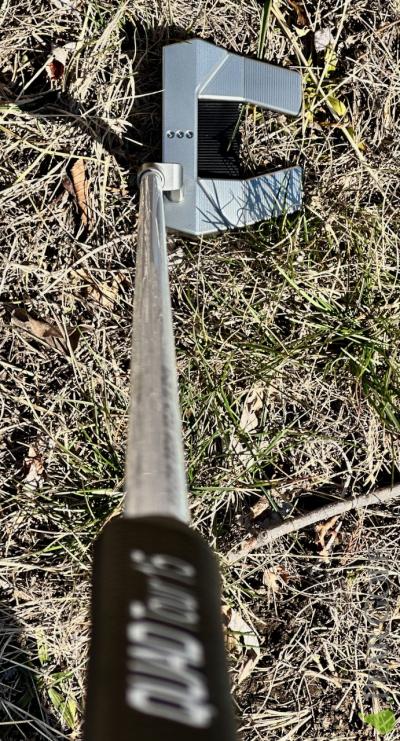

推桿的設定原理/How to setup your putter!~上集
https://www.peargolf.com/article/tuigandeshedingyuanlihow-setup-your-put...
下集開始。
第二種桿頭是大家說的小烏龜,也就是Mallet,桿頭比較大且扁平設計。這類桿頭特性就是好瞄球,桿頭慣性大,容易控制桿面,桿面不容易偏。對於近和中距離狀況比較好掌握但長距離的控制就不如傳統刀背桿頭。尤其一些桿頭是鋁合金材質,力量vs距離就真的落差超大。你覺得你推的很大力,但反應到距離上還不如刀背的一半。推桿的材質密度越高,對距離的效能就越好。
小烏龜桿頭有很多種外型,很多桿頭也都設計有配重螺絲,可以自行去調整桿頭重量,而這類桿頭的重量大多是350~380g。主要針對一般球友是以手臂和握力去推擊,因為它們也會配置比較大的握把,讓球友可以更容易去操控和掌握推桿。另外這個桿頭還有一個好處就是,可以容易去設定中、長的推桿長度,因為桿頭設計容易瞄準,同時也可以去調整重量,對於喜歡握推桿在靠近身體和身材高大的球友是個好處。
不過,這類推桿也是可以讓一般球友更容易去控制球桿,因為力學原理,你不需要握在桿子的後端來操控,如果推桿長度稍微長一點(中尺36~40“),你可以雙手握在球桿的一半位置,這樣你更容易去控制球桿,同時也是最省力的方式。就像給你一支棍子,你覺得握在2端之一位置容易,還是中間?同樣道理,這樣的推桿設定都是讓球友更容易去操控球桿。
我自己的推桿裡,就是2類推桿,而這2類推桿都是可以讓我容易和快速去掌握推桿。一種就是傳統刀背配置短長度和輕總重,另一種就是這類中尺推桿設定。核心就是用最小/最少的力量去操控推桿,這樣身體就更容易去控制特定部位運動和球桿本身。中尺推桿需要有一定重量,只是利用推桿特性,握在一半位置去操控球桿,球桿本身的穩定性更好,重量導致推桿使用上不容易去偏移,而且某種程度上,這類設定也像零扭矩推桿桿頭設計。
最後一個關鍵在,球友必須要建立一個推桿的經驗值。推桿經驗值是你對不同推桿設計和規格的使用經驗值,因為不同長度設定,桿頭重量、桿頭設計與握把,都會對你產生不同程度的衝擊與影響。而如果你沒有這些衝擊和經驗值,那你很難去找出最適合你使用的推桿設計和規格。我自己就是有幾十隻推桿在我自己的收藏裡,每一支推桿的設計、規格都不同,當然有一些是以我個人使用為基礎去做設定,規格上差不多,用起來就可以快速發揮。
沒有對的推桿就無法得到好的成績或結果,對的推桿是講究長期使用的一致性和穩定性,不是一兩場的低推桿數。上面是我個人對推桿設定的一個基本邏輯,都是以力學、物理學和材料學為基礎。你也可以套用,近而去找到適合你的推桿。產品一定有差異,而只要生活在地球上,這些原理就是不變。這也是你要去堅持和利用的東西!
The key takeaway here is that the moment of transition from stillness to movement requires the most energy. If the putter is too heavy, the shoulders might struggle to start the stroke, causing instability. Precision and consistency in body movement and club control are crucial in putting—small mistakes can lead to big consequences. That’s why the putter setup must align with your body mechanics.
The second type of putter head is the mallet, often called the “turtle” putter due to its larger and flatter design. Mallet putters are easier to align, have higher inertia, and help stabilize the putter face, making them more forgiving on short to mid-range putts. However, they don’t offer the same level of distance control as blade putters, especially for long putts. Some mallet putters are made from aluminum alloys, which can significantly affect distance control. You might feel like you’re making a strong stroke, but the actual ball roll may not match your effort—sometimes achieving only half the distance of a blade putter. The higher the material density, the better the distance efficiency.
Mallet putters come in many shapes, often featuring adjustable weight screws to customize head weight. Most mallet putters weigh between 350-380g and are designed for players who use their arms and grip strength more in the stroke. They often come with larger grips to enhance control. Another advantage of mallet putters is that they can accommodate mid-length or long-length setups, making them a good option for taller players or those who like to keep the putter close to the body.
Unlike blade putters, mallet putters allow for a different gripping style. Instead of gripping the end of the shaft, you can hold the middle portion, especially with mid-length putters (36-40 inches). This reduces the effort needed to control the putter. Think of it like holding a stick—gripping it from the middle requires less effort than holding it from one end. This setup helps golfers achieve a more controlled and efficient stroke.
I personally use both types of putters—a traditional blade with a shorter length and lighter total weight, and a mid-length mallet setup. The key is to control the putter with the least amount of effort, allowing better body coordination and consistency. A mid-length putter requires a certain weight, but by gripping it higher up, stability improves, reducing the risk of misalignment. In a way, this setup functions similarly to zero-torque putter designs.
Finally, one of the most important aspects of putting is experience. Experience comes from using different putter designs and setups, as factors like length, head weight, head design, and grip all influence performance. If you lack this experience, it’s hard to determine which putter is best for you. I own over twenty of putters, each with unique designs and specs. While some are customized for my preferences, they all help me quickly adapt and perform.
Using the right putter is essential for achieving consistent results over the long term, not just for one or two rounds with a low putt number. My approach to putter setup is based on physics, mechanics, and material science. You can apply these principles to find the best putter for yourself. While putter designs vary, the fundamental laws of physics remain the same—understanding and applying them is key to improving your putting performance.
請尊重本站內容智慧財產權.勿未經洋梨高爾夫同意下進行非法轉載文章!如想進行文章轉載需求,請與下面電郵聯系!
本站新設新浪微博网?版:http://weibo.com/peargolf
手机版:http://weibo.cn/peargolf
大家可加入我的粉絲團,我會不定時將新的信息與活動發怖在微博與臉書,推特內.
- 如果想要發表回應,請先登入。


